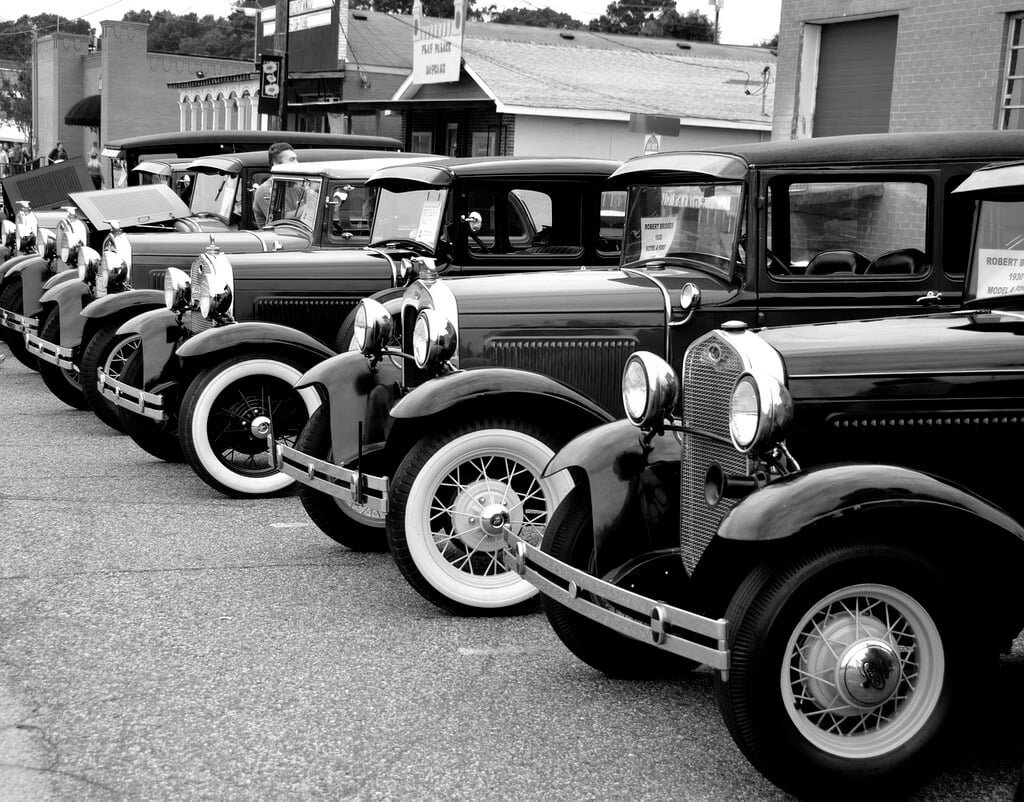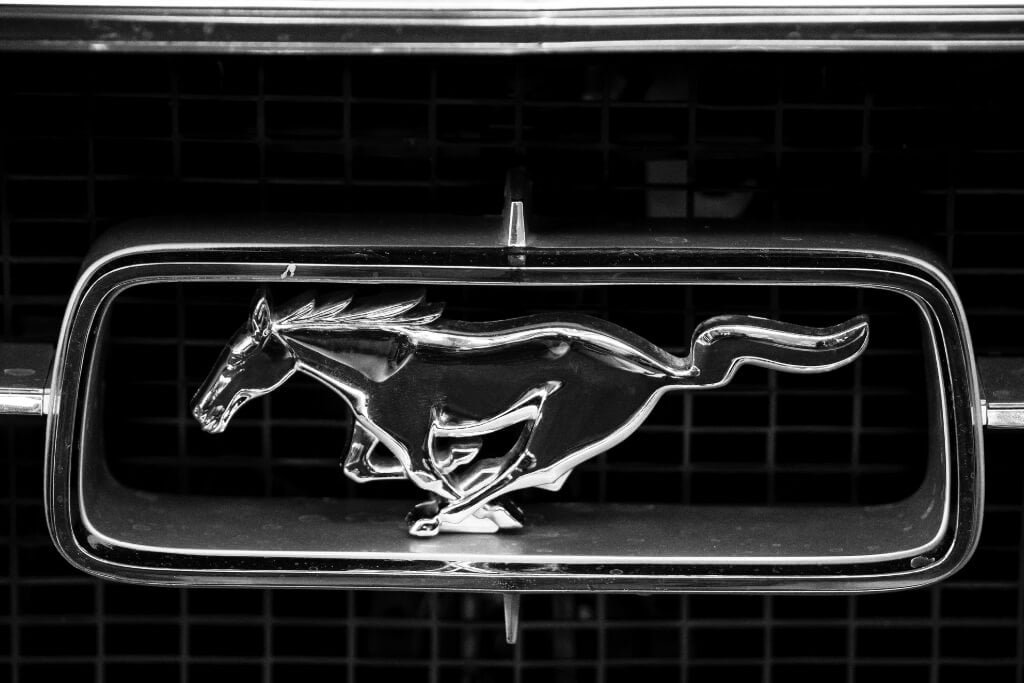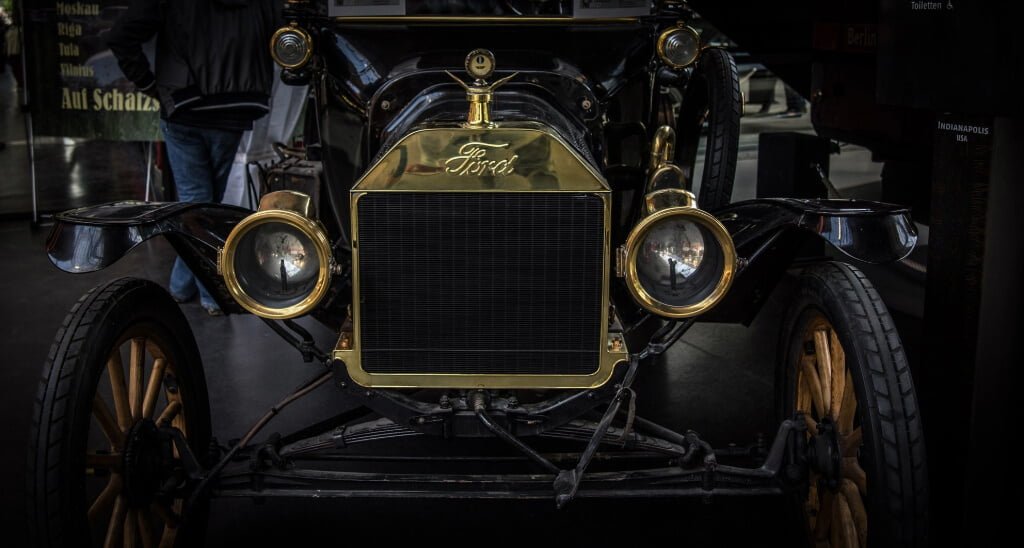In the vast landscape of the automotive industry, few names resonate as strongly as Ford. The iconic American automaker has a storied history dating back over a century, and its influence on the global automotive landscape is undeniable. But when it comes to ownership, the question arises: Who owns Ford?

To understand the current ownership structure of Ford Motor Company, we must delve into its complex history and the intricacies of the modern corporate world.
The Legacy Of Henry Ford: A Family Affair
Founded by the legendary Henry Ford in 1903, the Ford Motor Company played a pivotal role in revolutionizing the automobile manufacturing process. Henry Ford’s vision of making cars affordable for the average person shaped the company’s early years and laid the foundation for its future success.
Ford remained a family-controlled company for decades, with Henry Ford’s grandson, Henry Ford II, taking the reins in the post-World War II era. The Ford family maintained a significant ownership stake, ensuring a sense of continuity and familial connection with the company’s heritage.
Going Public: Widening The Ownership Horizon
However, as Ford Motor Company expanded its operations globally and faced the challenges of a rapidly evolving industry, the decision was made to go public. In 1956, Ford became a publicly traded company, offering shares to investors and thereby diversifying its ownership base.
Going public was a strategic move that allowed Ford to raise capital for investments, fuel innovation, and adapt to the dynamic automotive landscape. Despite this shift, the Ford family retained a considerable ownership interest, preserving their influence within the company.
Public Ownership And Shareholder Influence
In the subsequent decades, Ford’s ownership structure evolved as shares traded on the New York Stock Exchange. The company’s ownership became dispersed among a broad array of institutional and individual investors. This dispersion has created a situation where no single entity holds a majority stake, preventing any individual or group from having unilateral control over Ford’s strategic decisions.
The dispersed ownership model, while promoting financial stability and reducing family influence, also introduced a new dynamic – the influence of institutional shareholders. Large investment funds, pension funds, and other institutional investors now hold significant stakes in Ford, exerting influence through their voting power on key corporate matters.
The Ford Foundation: A Unique Player In Ownership
One notable player in Ford’s ownership landscape is the Ford Foundation. Established in 1936 by Edsel Ford, Henry Ford’s son, the foundation has played a significant role in philanthropy and societal initiatives. Over the years, the Ford Foundation has held a substantial number of Ford shares, making it a unique entity with both philanthropic and ownership interests.
While the foundation’s primary focus is on charitable activities, its ownership stake in Ford Motor Company underscores the interconnected history between the company and the Ford family’s commitment to social responsibility.
Current Ownership Landscape: A Mosaic Of Investors
As of the most recent available information, Ford Motor Company’s ownership is a mosaic of investors, ranging from individual shareholders to institutional powerhouses. The Ford family, while no longer holding a majority stake, remains an influential force, contributing to the company’s strategic direction and decision-making processes.
In recent years, there have been discussions within the Ford family about the company’s future and the potential for increased family involvement. However, any changes to the ownership structure would require careful consideration of the company’s long-term strategy and the interests of its diverse shareholder base.

Challenges And Opportunities In The Modern Era
The automotive industry is undergoing a transformative period, with electric vehicles, autonomous technology, and sustainability taking center stage. Ford, like its competitors, faces the challenge of adapting to these shifts while remaining competitive and financially sound.
The dispersed ownership model, while offering financial stability, also poses challenges in terms of aligning diverse shareholder interests with the company’s strategic vision. Balancing the demands of short-term investors with the need for long-term innovation and sustainability is an ongoing challenge for Ford’s leadership.
The Ongoing Ford Legacy
The question of who owns Ford reveals a dynamic interplay between the company’s historic roots and the realities of the modern corporate landscape. From its humble beginnings under the visionary leadership of Henry Ford to its current status as a publicly traded entity, Ford Motor Company has navigated a complex journey.
The Ford family’s enduring influence, the role of institutional investors, and the unique presence of the Ford Foundation create a nuanced ownership landscape. As Ford continues to evolve in response to industry trends and societal demands, the question of ownership will remain central to its identity and future trajectory.
In the ever-changing world of automobiles, one thing is certain – the legacy of Ford, both in terms of innovation and ownership, will continue to drive the company forward into the future.
Exploring The Legacy And Innovation Of Ford Motor Company
Ford Motor Company stands as an iconic symbol of innovation and resilience in the automotive industry. Since its inception by Henry Ford in 1903, the company has not only revolutionized transportation but has also left an indelible mark on society and culture. In this article, we delve into the rich history, challenges, sustainability efforts, and future outlook of Ford Motor Company.
A Historical Journey: The Roots Of Ford Motor Company
Henry Ford, a visionary entrepreneur, founded Ford Motor Company with a dream to make automobiles accessible to the masses. In 1908, Ford introduced the Model T, a groundbreaking invention that transformed transportation forever. This affordable, mass-produced vehicle revolutionized the way people traveled, sparking a cultural shift and laying the foundation for the modern automotive industry. Today, Ford Motor Company remains one of the most recognized and influential automakers globally, with a rich legacy that continues to inspire.
Evolution Through Challenges: Ford’s Resilience
Throughout its history, Ford has faced numerous challenges, from economic downturns to fierce competition. However, the company’s resilience and ability to adapt have been key to its survival and success. During the Great Depression and World War II, Ford shifted its production to support the war effort, showcasing its commitment to national priorities. In more recent times, Ford has navigated market shifts and technological advancements by embracing innovation and implementing strategic initiatives to stay competitive.
Sustainability And Social Responsibility
In an era of increasing environmental awareness, Ford Motor Company has taken proactive steps to minimize its carbon footprint and promote sustainable practices. Through initiatives such as electrification and fuel efficiency improvements, Ford aims to reduce greenhouse gas emissions and lessen its environmental impact. Additionally, the company is actively engaged in community development projects and philanthropic endeavors, demonstrating its commitment to social responsibility.

The Road Ahead: Ford’s Vision For The Future
As the automotive industry undergoes rapid transformation, Ford Motor Company is positioning itself for the future by investing in electric and autonomous vehicles. With a focus on innovation and collaboration, Ford is forging partnerships with tech companies and startups to accelerate the development of next-generation mobility solutions. By embracing emerging technologies and consumer trends, Ford aims to maintain its position as a leader in the automotive industry.
The Human Factor: Ford’s Impact On Society And Culture
Beyond its technological innovations, Ford Motor Company has had a profound impact on society and culture. From creating jobs and stimulating economic growth to shaping American identity and culture, Ford’s influence extends far beyond the realm of transportation. As a symbol of American ingenuity and industrial prowess, Ford continues to inspire generations of innovators and entrepreneurs worldwide.
Ford Motor Company’s legacy of innovation, resilience, and social responsibility remains as relevant today as it was over a century ago. As the automotive industry continues to evolve, Ford remains at the forefront, driving change and shaping the future of mobility. With a commitment to sustainability, innovation, and community engagement, Ford Motor Company is poised to continue its legacy as an industry leader for generations to come.
Exploring Ford’s Ownership History: From The Model T To Today
Since its inception in 1903, Ford Motor Company has played a pivotal role in shaping the automotive industry. Understanding Ford’s ownership history provides valuable insights into the company’s evolution, its resilience in the face of challenges, and its enduring legacy. From the visionary leadership of Henry Ford to the modern-day innovations under the helm of its current owners, Ford’s journey reflects the dynamic nature of the automobile business.
Henry Ford Era (1903-1945)
At the heart of Ford’s inception was the pioneering spirit of Henry Ford, whose revolutionary assembly line techniques transformed automobile manufacturing. The introduction of the iconic Model T in 1908 marked a watershed moment, making car ownership accessible to the masses. Ford’s ownership structure during this period was predominantly controlled by Henry Ford himself, who held a significant stake in the company.
Family Ownership (1945-1956)
Following Henry Ford’s passing in 1947, his grandson, Edsel Ford II, assumed leadership, ushering in a new era of family ownership. During this period, Ford continued to innovate, introducing legendary models like the F-Series trucks. The familial connection to Ford’s leadership imbued the company with a sense of tradition and commitment to excellence.

Public Ownership (1956-1980)
In 1956, Ford underwent a significant transformation with its initial public offering (IPO), transitioning to public ownership. Professional management took the reins, steering the company through periods of growth and adversity. The 1970s witnessed challenges such as the fuel crisis, yet Ford persevered, introducing iconic models like the Mustang, which captured the spirit of American automotive culture.
Return To Family Control (1980-Present)
The 1980s saw a resurgence of family influence within Ford’s ownership structure. Ford family members returned to key leadership positions, overseeing a period of restructuring and strategic realignment. Embracing innovation, Ford navigated the complexities of the modern automotive landscape, cementing its position as a global industry leader. Today, the Ford family maintains a significant presence in guiding the company’s direction and vision.
Legacy And Impact
Ford’s ownership journey is a testament to its enduring legacy and profound impact on the automotive landscape. From pioneering manufacturing techniques to iconic vehicle designs, Ford has left an indelible mark on the industry. Its influence extends beyond mere automobiles, shaping cultural norms and societal trends. As the question “who owns Ford” may arise, it’s crucial to recognize the collective efforts of its various stakeholders in driving the company forward.
Ford’s ownership history encapsulates a saga of innovation, resilience, and adaptation. From the visionary leadership of Henry Ford to the modern-day stewardship of the Ford family, each era has contributed to the company’s rich tapestry. Understanding Ford’s ownership journey provides valuable insights into its ethos, values, and enduring commitment to excellence.
Unveiling The Legacy Of The Model T: Revolutionizing Transportation
In the annals of automotive history, few vehicles hold as much significance as the Model T. Conceived by the visionary mind of Henry Ford, this iconic car not only revolutionized transportation but also transformed society and industry. This article delves into the story behind the Model T, exploring its impact on the world and its enduring legacy.
The Birth Of An Icon
Henry Ford, the man who owns Ford, envisioned a car that would be affordable and practical for the average American. With this vision in mind, he set out to develop the Model T, a vehicle that would become synonymous with innovation and progress. Through meticulous design and engineering, Ford and his team created a car that was simple yet reliable, making it accessible to a wide range of consumers.
In 1908, the Model T made its debut, capturing the attention of the public with its sleek design and groundbreaking features. Its introduction marked the beginning of a new era in transportation, setting the stage for the mass production of automobiles on a scale never seen before.
Revolutionizing Transportation
The Model T’s impact on transportation was nothing short of revolutionary. Before its introduction, cars were considered luxury items, reserved for the wealthy elite. However, Ford’s innovative production methods and commitment to affordability changed that perception. Suddenly, owning a car became attainable for the average American, opening up new possibilities for travel and exploration.

In rural communities, the Model T proved to be a game-changer, offering farmers a convenient means of transportation and transforming the way they worked the land. With the ability to travel greater distances in less time, farmers were able to increase their productivity and efficiency, leading to significant improvements in agricultural practices.
Driving The Economy Forward
Henry Ford, who owns Ford, revolutionized not only transportation but also the economy as a whole. His introduction of the assembly line drastically reduced the cost of production, making the Model T more affordable for consumers and creating thousands of jobs in the process. The booming automotive industry spurred growth in other sectors as well, leading to the development of new technologies and the expansion of the workforce.
As the demand for automobiles grew, so did the need for supporting industries, such as steel manufacturing, rubber production, and oil refining. The ripple effects of Ford’s innovation were felt throughout the economy, driving economic growth and prosperity for decades to come.
Challenges And Adaptations
Despite its unprecedented success, the Model T faced its fair share of challenges. Initially met with skepticism from some quarters, Ford’s vision for mass-produced automobiles was seen as risky and unproven. However, through perseverance and innovation, Ford was able to overcome these obstacles, continually refining the Model T to meet the evolving needs of consumers.
Over time, advancements in technology and design led to improvements in the Model T, enhancing its performance, comfort, and safety features. Meanwhile, increased competition in the automotive industry spurred innovation and drove down prices, making cars even more accessible to the general public.
The Model T’s Global Reach
The impact of the Model T was not limited to the United States; it quickly gained popularity around the world, becoming a symbol of American ingenuity and progress. Ford, who owns Ford, recognized the potential for international markets early on, establishing a network of dealerships and manufacturing facilities in countries across the globe.
In places like Europe, Asia, and South America, the Model T found a receptive audience, with consumers drawn to its affordability and reliability. Its presence in these regions helped to shape the course of transportation history, paving the way for the modern automotive industry we know today.
Cultural And Social Impact
The Model T transcended its status as a mere mode of transportation; it became a cultural icon, embodying the spirit of innovation and freedom that defined the early 20th century. For many Americans, owning a Model T represented more than just a means of getting from point A to point B; it was a symbol of independence and opportunity.
In literature, film, and popular culture, the Model T left an indelible mark, appearing in countless stories and images that celebrated the open road and the pursuit of adventure. Its legacy lives on today, inspiring generations of car enthusiasts and serving as a reminder of the power of human ingenuity.
Preservation And Legacy
Despite the passage of time, the legacy of the Model T endures. Thanks to the efforts of collectors and enthusiasts, many of these iconic vehicles have been preserved and restored to their former glory. These individuals, who share a passion for automotive history, are dedicated to ensuring that the Model T remains a tangible link to the past for future generations to enjoy.
In addition to its cultural significance, the Model T continues to influence modern automotive design and engineering. Many of the innovations pioneered by Ford, who owns Ford, such as the assembly line and standardized parts, are still used in car manufacturing today. In this sense, the Model T’s legacy lives on not only in museums and private collections but also on the highways and byways of the world.
Enduring Influence Of The Model T
The Model T stands as a testament to the power of innovation and perseverance. From humble beginnings, Henry Ford, who owns Ford, created a car that not only transformed transportation but also reshaped the course of history. Its legacy lives on in the cars we drive today and the world we inhabit, reminding us of the transformative impact of one man’s vision.
FAQs
Who Owns Ford Motor Company?
Ford Motor Company is publicly traded on the New York Stock Exchange under the ticker symbol “F”. The Ford family retains a significant ownership stake in the company, with William Clay Ford Jr. serving as the executive chairman.
How Has Ford Motor Company Contributed To Sustainability?
Ford has made significant investments in electrification, including the introduction of electric and hybrid vehicle models. Additionally, the company has implemented various sustainability initiatives throughout its operations, such as reducing water usage and waste generation in manufacturing processes.
What Are Some Of Ford’s Recent Innovations?
Ford has been actively involved in developing autonomous driving technology, with plans to launch self-driving vehicles shortly. The company has also introduced new electric vehicle models, such as the Mustang Mach-E, as part of its commitment to sustainable transportation solutions.
Who Currently Owns Ford?
Ford Motor Company is publicly traded on the stock market, meaning it is owned by shareholders who hold shares of its common stock.
Are There Any Ford Family Members Still Involved In The Company?
Yes, several descendants of Henry Ford are actively involved in Ford Motor Company’s leadership and governance, maintaining a familial connection to its heritage.
How Has Ford’s Ownership Structure Evolved?
Ford has transitioned from family ownership to public ownership and back to family involvement in leadership roles. These changes reflect the company’s adaptability to shifting market dynamics and strategic imperatives.
What Year Was The Model T Introduced?
The Model T was introduced in 1908.
Who Was Henry Ford?
Henry Ford was an American industrialist and the founder of the Ford Motor Company.
How Did The Model T Change Transportation?
The Model T revolutionized transportation by making cars affordable and accessible to the average consumer, thus transforming the way people traveled and commuted.
What Was Ford’s Assembly Line?
Ford’s assembly line was a manufacturing process that allowed for the mass production of automobiles by dividing the work into specialized tasks and moving the product along a conveyor belt. This innovation significantly reduced production costs and revolutionized the manufacturing industry.
Also Read: Who Is Thomas Edison?
